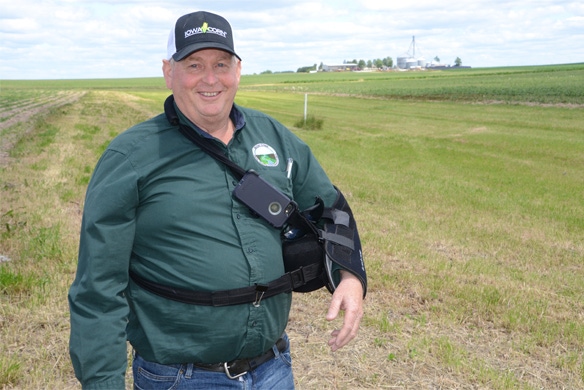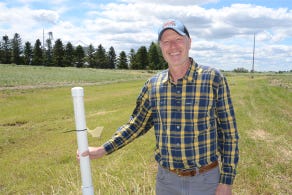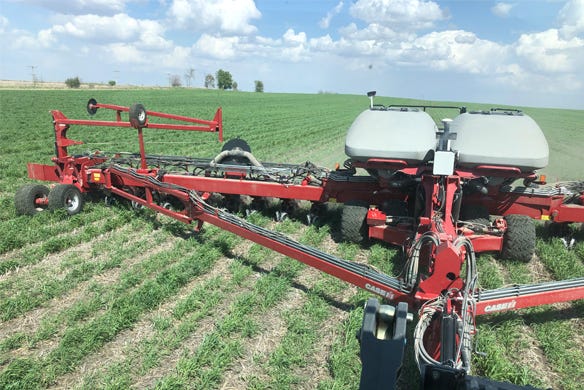November 8, 2021

If you call Rick Rottinghaus at the right time, you might be invited to his farm near Jesup, Iowa, to help out. Most likely it will be a request to run an air seeder right behind the combine. "We can always use the help if you're available," he quips. But his real work is in constant improvement of the land he farms, including some innovations in water management.
That air seeder is a key to his cover crop program, a move he made several years ago in part due to a labor shortage, too. "We were on ridges, and I couldn't get anyone to cultivate," he recalls. "We went away from ridges. Then I started working with cover crops."
More on those cover crops and what he's learned later. What brought Wallaces Farmer to the Rottinghaus farm was an innovative installation he made on his operation. Rottinghaus has installed a saturated buffer in a waterway — not near a stream, which is more common.
Rottinghaus is on the advisory board for the Miller Creek Water Quality Project. It's an education to understand how water flows in the region, and how the watershed drains into the Cedar River flowing through eastern Iowa and on to the Mississippi.
The bigger picture
The Miller Creek Watershed is part of the larger Middle Cedar River Watershed, encompassing 1.5 million acres in east-central Iowa. All of Rottinghaus' land is in the Middle Cedar Watershed.

MEASURING PERFORMANCE: Clark Porter, environmental specialist with the Iowa Department of Agriculture and Land Stewardship, stands next to one of the measurement locations where samples are taken to measure water leaving the Rottinghaus waterway. Kent Heikens, USDA, Ames, Iowa, has been taking measurements from those wells. (Willie Vogt)

Clark Porter, an environmental specialist with the Iowa Department of Agriculture and Land Stewardship, is assigned to Miller Creek and works with colleagues as needed within the larger Middle Cedar Watershed. "The Miller Creek Watershed is about 61,000 acres of that area," Porter says. He explains that the Middle Cedar Watershed is one of several priority watersheds in Iowa that have been targeted for water quality improvement. Targeted projects in the watershed receive additional state, federal and even private funding through a variety of programs and sources. Aside from concerns about excess nutrients flowing into the Mississippi and the Gulf of Mexico, the city of Cedar Rapids sits at the base of the Middle Cedar and relies on alluvial wells within the Cedar River valley for drinking water. Porter appreciates Rottinghaus’ expertise, support and innovative thinking.
Porter explains the total watershed was funded by a $97 million grant awarded to the state by the U.S. Housing and Urban Development, under the title "Iowa Watershed Approach." The money is being used to better manage the watershed and measure the water quality in the area, which is about 73% farmland.
Rottinghaus was seeking opportunities in watershed management, and he looked at ways to reduce runoff and improve water quality for whatever drains away from his farm. "I'm looking for things that will benefit the farmer also; saturated buffers or bioreactors don't directly benefit the farmer but do benefit the environment," he says.
He saw the saturated buffer as the right choice for his operation because it keeps nitrogen from leaving the farm at a lower cost than alternatives.
In addition, Rottinghaus sees a lot of these mitigation efforts focused on the field edges. "You want to do more than at the edge of the field to improve soil quality, water quality and hold nutrients," he says.
Choosing that buffer approach
The saturated buffer Rottinghaus installed — with no financial help from USDA, because that comes only when those buffers are placed near streams or rivers — was his investment in the farm. "I was going to install it in 2017, and waited for support, but that didn't come through," Rottinghaus says. "I installed it myself."
Rottinghaus was grading the waterway and got the idea of putting in a saturated buffer. Essentially, the saturated buffer "traps" water, slowing its discharge into a tile line or stream to let natural processes work through the nitrogen that might be coming off the farm.
Kent Heikins, with USDA at the National Laboratory for Ag and the Environment in Ames, Iowa, shares that saturated buffers offer promise. "We've been doing saturated buffers for 12 years in our lab, and we're confident they work," he says. "Nature is removing that nitrogen by itself, and we're taking advantage of that when sending water into the saturated buffer."

COVER CROP DIFFERENCE: Rottinghaus plants into cover crops that he seeds postharvest with an air seeder. That practice has already reduced the measured level of nitrogen leaving the farm according to Kent Heikens, with USDA in Ames, Iowa. (Courtesy of Rick Rottinghaus)

While saturated buffers near water features have been common, Heikens says his lab has been looking at different kinds of landscapes where they may be deployed. He recalls being alerted by Porter that Rottinghaus was going to use his own equipment to install the system.
"He purchased the boxes and did the tile himself," Heikens says. "He had to redo a large tile in the waterway."
Rottinghaus installed an impermeable 10-inch pipe that essentially flowed "uphill," so water draining into it was carried back to the top of the waterway, where it would then work its way down. Two boxes — one at the top and one at the bottom — would slow the water from eventually leaving the waterway. That allowed for the natural denitrification process.
"You can't drive across the waterway when the buffer is filled," Rottinghaus says. "But it's dry at the top." That's a cost he's willing to pay on his farm.
DIY installation
Rottinghaus notes that the cost of the two boxes for the saturated buffer was about $700 each, and his own time and materials for the tile line. He estimates the total cost at about $1,800 to install the buffer, and he's considering the practice on other parts of his farm.
While Rottinghaus may be contemplating another saturated buffer in a waterway, the idea may catch on in other parts of the state. Heikens says USDA is looking at other parts of the state where this might happen. "We're looking for more waterways to do this in, and do some more monitoring," he says. "If we want to get a load of nitrogen removed, we need to get flow. We're looking at it more extensively."
Heikens says that given the drought of 2021, it has not been a good year to study saturated buffers; but even though it's been dry, the flow at the Rottinghaus buffer has been good.
He adds that Rottinghaus’ use of cover crops puts him ahead in work to keep nitrogen on the field where it was applied. "The water running into those boxes was at its highest at 12 to 14 ppm, and the average across two years was 10 ppm," he says. "He's already sort of ahead of the curve with the quality of his water going into the tile line."
Heikens is working to do more tests at the Rottinghaus farm to explore how water moves through the tile lines. The waterway is part of drainage for a 740-acre field.
Cover crops make a difference
As Heikens says, Rottinghaus was ahead of the curve with his cover crop use. He was a longtime user of ridge till, but turned to no-till because it became difficult to find labor for cultivation. And he went to a corn-soybean rotation.
Rottinghaus was looking at ways to boost soil health and turned to cover crops. "I had 60-pounds flown on by airplane into the crop," he recalls. "But I was only seeing 10% germination. In five years of doing that, I got two years of a decent stand."
Knowing he needed a better approach, he turned to using an air seeder following the combine in the fall. He notes that he's using only 30 pounds of cereal ryegrass seed in the fall, versus 60 pounds, and seeing a higher germination rate. "I'm getting at least 40% germination and better coverage," he says.
Labor is still a problem, because that air seeder is following two combines at harvest. "I need someone to run it," he says.
As for costs? He figures he's paying $6 per acre for the seed at 30-pounds per acre, and he's using what he calls a "cheap" air seeder. His application cost is about $14 per acre. "We get a better stand that's more consistent with the drill. He plants the drill on 10-inch spacing with a 20-inch gap. He plants into that 20-inch gap in the spring, and then terminates the cover crop after planting. He uses a burndown application with a residual herbicide to get the crop off to a good start.
Using no-till and cover crops is working for Rottinghaus. It's all about continuous learning for him. He recalls an eighth-grade textbook from the 1930s that said, "Moldboard plows save moisture." When Rottinghaus read that, he says, "I burst out laughing. We've learned a lot."
About the Author(s)
You May Also Like






